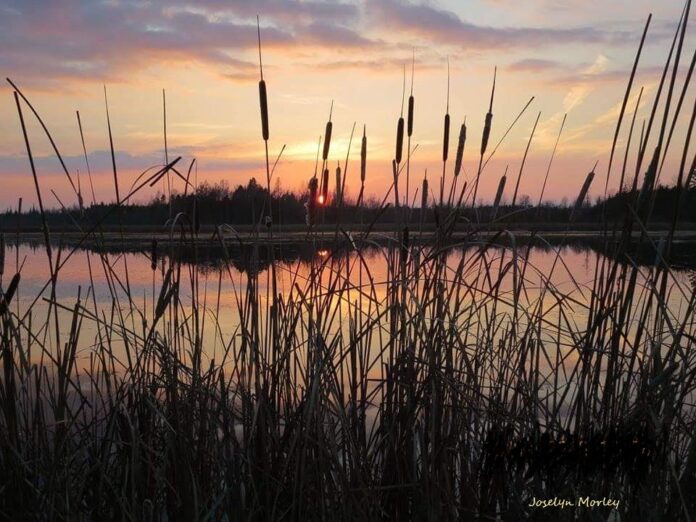Wetlands are diverse, but generally a wetland is land that has been saturated with water long enough that aquatic plants can grow. They are transitional areas between rivers or lakes, and more arid land of higher elevation. Some wetlands are permanently covered in water, and some flood only in spring or at times of extreme weather. We have four basic types of wetlands in Ontario. A bog is an area of peat, which is long-decaying plants. They are very acidic, and covered in mosses, with occasional stunted black spruce trees. There are more wetlands in northern Ontario than there are here, although most people are familiar with Mer Bleu Bog east of Ottawa. A fen is also a wetland that accumulates peat. These are areas where groundwater discharges to the surface. They are less acidic and soil has more nutrients. There are grasses, reeds, tamaracks and cedar. Marshes are periodically or permanently flooded, with a variety of marsh vegetation such as cattails, reeds, rushes, and grasses. There is also water plants such as water lilies. They are often found around bigger areas of water like lakes or rivers. Swamps are wetlands in the woods, where flooding is usually for a portion of the year. They support a variety of coniferous and deciduous trees, including willow, cedar, and dogwood. They are extremely diverse.
Our wetlands are being depleted at an alarming rate. They are some of the most bio-diverse areas of our landscape, yet we do not value “swamp” land. Some areas of Canada have lost over 90% of our wetlands. Wetlands reduce flooding and drought by regulating moisture. They are sponges that capture and slowly release water throughout the watershed or floodplain. They prevent water runoff and erosion. They reduce the damage done by storm surges. They clean and filter our water to replenish underground aquifers. They sequester carbon, reducing greenhouse gasses, and help protect us from climate change.
Wetlands have been drained by successive generations of Canadians. Draining wetlands has been allowed in order to expand farmland, or increase land for development, but at what cost? Wetlands are an extremely diverse and complex ecosystem. Once gone, they do not come back. Some wetlands are given special designation as “provincially significant wetland,” but the majority of wetlands do not have such a designation, and as such are subjected to draining or filling without consideration of the consequence.
Wetlands host a huge variety of different species: plants, insects, amphibians, reptiles, birds, microbes, and mammals. They are many of the most bio-productive places on our planet. As climate change leads to more and more volatile and extreme weather events, we need the moderating and mitigating effects of wetlands all the more, at a time when they are increasingly under attack from development and agriculture. Mitigating climate change requires a multifaceted approach. It is not enough to try to reduce emissions. There has to be other actions. Nature-based solutions provide one such approach. Nature-based solutions involve protecting, enhancing, restoring, and sustainably managing ecosystems that can play a role in reducing the effects of climate change. Nature-based solutions can help alleviate some of the disastrous effects of many extreme climate emergencies.
In Ontario, there are programs for the landowner to encourage protection of wetlands. There is the Conservation Land Tax Incentive Program (CLTIP), which can provide a 100 percent property tax exemption on eligible conservation lands. The Managed Forest Tax Incentive (MFTI) can help to support a landowner in maintaining and managing woodlands, which can include wetlands. The Land Stewardship and Habitat Restoration Program (LSHRP) can provide up to $20 000 in matching funds to support a project that benefits or maintains a variety of habitat.





